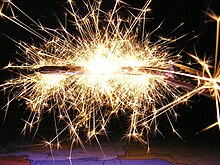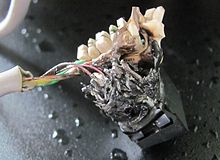Short circuit
The short circuit is the name given to the failure in an electrical appliance or line through which electrical current passes directly from the active conductor or phase to the neutral or ground in single-phase alternating current systems, between two or equal phases. to the previous case for polyphase systems, or between opposite poles in the case of direct current. That is to say: it is a low impedance defect between two points of different potential and produces electric arc, electrodynamic stresses and thermal stresses.
The short circuit is normally produced by failures in the insulation of the conductors, when they are submerged in a conductive medium such as water or by accidental contact between aerial conductors due to strong winds or breakage of the supports.
Because a short circuit can cause significant damage to electrical installations and even fire in buildings, these installations are normally equipped with fuses or magnetothermal switches in order to protect people and objects. It should also be noted that in alternating current systems they are produced by a difference in electrical phase angles.
Ohm's Law
In a closed circuit, the voltage, electric current and resistance must have properly controlled values for a proper functioning of the system. A short-circuit condition is determined by eliminating, from a practical point of view, the consumption resistance of the circuit. According to Ohm's law, we have
I=VR{displaystyle I={frac {V}{R}}}}
V=I⋅ ⋅ R{displaystyle V={I}cdot {R}}
Therefore, if the resistance is decreased to approximately zero, the intensity of the current tends to infinity. This situation occurs, for example, when a metal bar falls on the conductors and forms a bridge. In this case it is said that they have been "bridged" the live or phase and the neutral of the circuit, opposing this a resistance practically equal to 0 to the passage of electric current.
Joule effect
According to the Joule effect, the current flowing through a conductor generates heat that can be determined according to the relationship:
Q=I2⋅ ⋅ R⋅ ⋅ t{displaystyle Q=I^{2}cdot Rcdot t,}
So if the current acquires excessive values, the amount of heat can be such that it can melt the circuit conductors almost instantly, this being the most appreciable phenomenon in a short circuit.
Contenido relacionado
Angular moment
Naval Engineering
Polarity (electricity)





